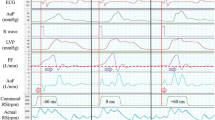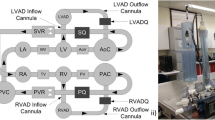Abstract
The NIPRO-ventricular assist device (NIPRO-VAD) is an external pulsatile flow pump. Formerly, Sorin Carbocast, a monoleaflet tilting disc valve (SC valve), was used at the inlet/outlet parts of the pump, but Medtronic Hall (MH valve) is now used. We studied the differences in performance among pumps with different artificial valves. Six NIPRO pumps with SC valves and six with MH valves were examined using mock circuits. The systolic flow of the pump was measured with the ultrasonic flowmeter by changing the systolic fraction. Six patients wearing the NIPRO-VAD underwent periodic pump exchange from a pump with an SC valve to the one with an MH valve. The pump blood flow was measured at pre- and post-pump exchanges using an ultrasonic flowmeter. Blood pressure, serum LDH and AST levels were also compared before and after the pump exchange. Blood flow was significantly increased by using the NIPRO-VAD with the MH valve as compared to the SC valve in vitro. Under the same drive conditions pump flow tended to increase in six patients. No difference was found in patients’ blood pressure, serum LDH or AST levels when using the SC or MH valve. From these results, the hemodynamic influence on patients due to replacement of the SC valve with the MH valve in the NIPRO-VAD is considered to be insignificant.



Similar content being viewed by others
References
Saito S, Matsumiya G, Sakaguchi T, Fujita T, Kuratani T, Ichikawa H, Sawa Y. Fifteen-year experience with Toyobo paracorporeal left ventricular assist system. J Artif Organs. 2009;12:27–34.
Sasaoka T, Kato TS, Komamura K, Takahashi A, Nakajima I, Oda N, Hanatani A, Mano A, Asakura M, Hashimura K, Niwaya K, Funatsu T, Kobayashi J, Kitamura S, Shishido T, Wada K, Miyata S, Nakatani T, Isobe M, Kitakaze M. Improved long-term performance of pulsatile extracorporeal left ventricular assist device. J Cardiol. 2010;56:220–8.
Shiga T, Kinugawa K, Hatano M, Yao A, Nishimura T, Endo M, Kato N, Hirata Y, Kyo S, Ono M, Nagai R. Age and preoperative total bilirubin level can stratify prognosis after extracorporeal pulsatile left ventricular assist device implantation. Circ J. 2011;75:121–8.
Takano H, Taenaka Y, Matsuda T, Umezu M, Nakamura T, Hayashi K, Akutsu T, Manabe H. Development of the clinical ventricular assist system: modification of the blood pump and its evaluation. Jpn J Artif Organs. 1983;12:390–4.
Nishimura T, Kyo S. High-dose carvedilol therapy for mechanical circulatory assisted patients. J Artif Organs. 2010;13:88–91.
Schima H, Reindl C, Stoiber M, Rothy W, Wieselthaler G. Emergency reinforcement of cracked paracorporeal blood pumps. ASAIO J. 2004;50:621–3.
Takano H, Taenaka Y, Nakatani T, Umezu M, Matsuda T, Iwata H, Tanaka T, Noda H, Hayashi K, Takatani S, Nakamura T, Seki J, Akutsu T, Manabe H. Circulatory maintenance with a single artificial heart. Trans Am Soc Artif Intern Organs. 1984;30:550–5.
Flachskampf FA, O’Shea JP, Griffin BP, Guerrero L, Weyman AE, Thomas JD. Patterns of normal transvalvular regurgitation in mechanical valve prostheses. J Am Coll Cardiol. 1991;18:1493–8.
Shivakumaraswamy T, Mishra P, Radhakrishnan B, Khandekar J, Agrawal N, Patwardhan A, Khandeparkar J. Intravascular hemolysis in patients with normally functioning mechanical heart valves in mitral position. Ind J Thorac Cardiovasc Surg. 2006;22:215–8.
Akagawa E, Lee H, Tatsumi E, Homma A, Tsukiya T, Katagiri N, Kakuta Y, Nishinaka T, Mizuno T, Ota K, Kansaku R, Taenaka Y. Effects of mechanical valve orifice direction on the flow pattern in a ventricular assist device. J Artif Organs. 2007;10:85–91.
Nakata M, Masuzawa T, Tatsumi E, Taenaka Y, Nishimura T, Tsukiya T, Takano H, Tsuchimoto K, Ohba K. Characterization and optimization of the flow pattern inside a diaphragm blood pump based on flow visualization techniques. ASAIO J. 1998;44:M714–8.
Lee H, Tatsumi E, Taenaka Y. Flow visualization of a monoleaflet and bileaflet mechanical heart valve in a pneumatic ventricular assist device using a PIV system. ASAIO J. 2010;56:186–93.
Author information
Authors and Affiliations
Corresponding author
Rights and permissions
About this article
Cite this article
Kimura, M., Nishimura, T., Kinoshita, O. et al. Hemodynamic influence of tilting disc valve type on pump performance with the NIPRO-ventricular assist device. J Artif Organs 15, 134–139 (2012). https://doi.org/10.1007/s10047-011-0616-2
Received:
Accepted:
Published:
Issue Date:
DOI: https://doi.org/10.1007/s10047-011-0616-2




